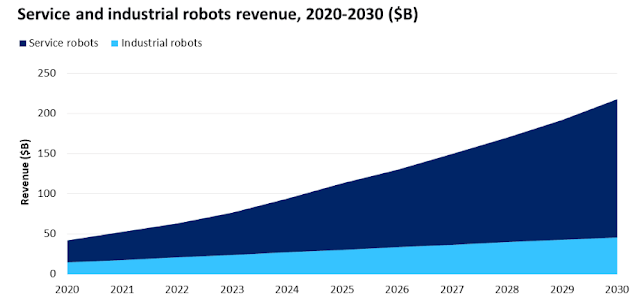Robotics have become the cornerstone of modern manufacturing, revolutionizing many industries across the globe. The applications span from automating repetitive tasks to enhancing precision and efficiency in complex operations.
With the relentless pursuit of operational excellence, and the increasing need for production agility and cost-effectiveness, the demand for industrial robots continues to surge.
Based on current estimates, there are already well over three million industrial robots installed worldwide, and the pace of installation is increasing rapidly.
Industrial Robotics Market Development
Moreover, robotics use cases are proliferating from shelf stacking, to cleaning, and various forms of manufacturing. Robots are important to economic growth, as nations struggle with labor shortages and aging populations.
Against this growing applications backdrop, the robotics market is forecast to reach $218 billion by 2030, according to the latest worldwide study by GlobalData.
Numerous business sectors that will be impacted by robot adoption -- including industrial, medical, logistics, manufacturing, inspection, cleaning, agriculture, defense, security, and consumer goods.
As robotic intelligence becomes more sophisticated and capable of more complex tasks, autonomous machines will become increasingly prevalent in the home and perhaps in more types of workplace.
"Within healthcare, an increasing number of surgeries are being carried out or assisted by robots. Robots in warehouses and distribution centers are enabling high-efficiency logistics. And on the consumer side, autonomous vacuum cleaners have become commonplace in many households," said Isabel Al-Dhahir, senior analyst at GlobalData.
Advances in artificial intelligence (AI) have expanded the development of robots, allowing them to become highly complex systems rather than the stand-alone, limited fixed-function machines.
AI has increased the number of roles that robots can now perform. Cloud computing is central to this advancement that improves sensing, computation, and memory to be managed more securely.
In addition to technological progress, the adoption of robots has impacted current global events. For example, the Russia-Ukraine war has increased the sales of military drones and accelerated their functionality.
Aging populations and low fertility rates in South Korea, Singapore, and Japan have driven the use of robots to meet gaps in the Asia-Pacific labor market.
Technology competition between China and the United States is also driving the robotics market as efficient, low-cost, and high-quality manufacturing becomes increasingly important to supply chains.
Outlook for Robotics Applications Growth
The overall impact to the global workforce has yet to be determined. "Robotics is impacting work by changing production lines and, in some cases, replacing human workers," Al-Dhahir concludes.
Technologies, such as co-bots and logistics robots, can turn factories into advanced engineering labs where assembly line processes and components are constantly analyzed, streamlined, and improved.
According to the GlobalData assessment, trade unions, policymakers, and social scientists are concerned that automation may lead to high levels of unemployment, particularly if the economy cannot create higher-value jobs for those workers that robots replace.
That said, there is also mounting evidence that artificial intelligence will create new types of jobs. However, some workers displaced by robotics will definitely require training in order to re-enter the workforce. Governments and business leaders must start to plan for these transitions.
